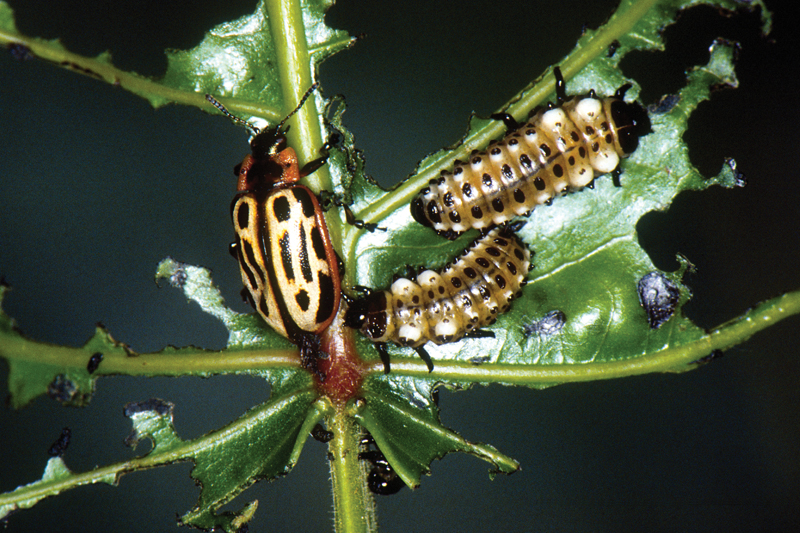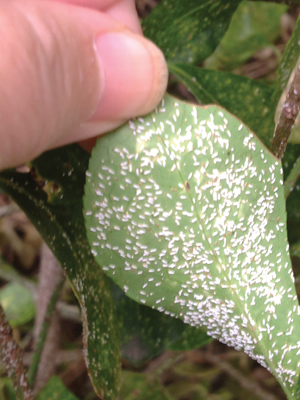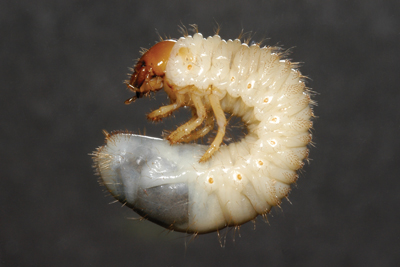
The cottonwood leaf beetle is a native pest of cottonwood, poplar, willow, aspens and alders throughout the United States. This damaging tree pest should be noted when scouting. Photos by James Kalisch, University of Nebraska-Lincoln
Dealing effectively with insect pests of golf turf and trees requires a common-sense, start-at-the-beginning approach. Experienced superintendents have likely read about and use the principles of integrated pest management (IPM), a philosophy of pest control that helps you to start at the beginning. IPM is a tried-and-true methodology with the potential for many control options, giving the superintendent a big toolbox with a full set of tools.
Scouting and monitoring
The most important tools a turfgrass scout can have are eyes. More specifically, it’s the capacity to notice early, telltale symptoms of possible insect damage. Your first step should be to develop a practical routine for pest monitoring. Be sure to consider that if the plan is too arduous, it’s not likely to be used or used well. Conversely, an overly simple plan isn’t likely to result in early pest detection.
To be clear, “scouting” and “monitoring” do have separate meanings, despite the terms often being used interchangeably. Scouting is a one-time endeavor; monitoring is a series of scouting events. Monitoring must be structured in such a way to be both feasible and effective. Think of it like the vegetable garden that is well placed in a residential landscape to be in full sun and on good soil for the veggies to grow well, but that must also be close enough to the back door so that it’s convenient enough to water, weed and harvest from on a regular basis.
Two approaches to monitoring are commonly used. Both are effective, but one may be more practical for your situation.
- Approach 1. All employees participate in scouting. All grounds/golf workers are always on the lookout for symptoms of pest damage, whenever they’re out on the course.
- Approach 2. The superintendent designates a scout or scouts. Scouts must have significant training in the turf and tree pests that are common in your region, be able to record them accurately, and be able to communicate them effectively to treatment decision-makers.
Diagnosing the problem
Spotting something suspicious in a turf stand or on a tree branch is one thing; accurately diagnosing the problem is another. The second tool to highlight is the training in diagnosis that can be obtained from mentors such as veteran superintendents, GCSAA seminars at the national and chapter level, and college courses. Your own experiences — both positive and negative — will also be crucial. Making an initial diagnosis that later turns out to be incorrect is just as helpful, if not more so, than getting it right the first time. Because of the implications of being incorrect, though, some inexperienced scouts may feel overwhelmed by the process of diagnosis. If that’s the case, breaking it into small parts — kind of like eating an entire elephant piece by piece — can be helpful.
The simplest method for diagnosis is to catch the actual culprit pest. This is especially appropriate when there are obvious insects present on turf leaves, roots and stems — you notice them and you collect them for identification. Baby food jars are good collection and temporary storage devices. Having the specimens on hand will better help you or an entomologist pinpoint your pest problem.
If damage or symptoms are present in turf but no insects are visible, you can dig up the whole plant and look closely at the roots, crowns and thatch. If digging up the plant isn’t an option, a flushing agent can be useful for drawing out some turf insect pests, such as chinch bugs. Mix up a concoction of a cup of lemon-scented dish soap in a 5-gallon bucket of water, transfer the mixture into a watering can, and slowly spread it over a square yard of turf. A watering can designed for flowers will produce the slow, steady and even infiltration you need as opposed to just dumping it on the surface, which won’t be effective.
Turf insects can be difficult to find, but at least the entire plant can be examined. That’s obviously not the case with trees. The crown and heartwood of a tree are usually not easily accessible, so you must rely on outward symptoms to diagnose a pest problem.
On trees and shrubs, insect damage usually looks like holes or chewed edges of leaves. Sometimes the holes appear more like “pokes,” as if someone had poked the leaf with a sewing needle — often referred to as “stippling” — where sucking pests such as aphids and leafhoppers have inserted their mouthparts and extracted plant juices. Chewing pests such as leaf beetles, borers, leaf miners and billbugs often create tunnels in leaf tissue. Others, such as caterpillars and white grubs, simply eat large portions of leaves and roots. They can also create holes in stems, causing premature yellowing of plants and plant parts. A soft, powdery, sawdust-like substance known as “frass” may also be present. These types of damage are all diagnostic and can help you to better strategize your pest management options.
Considering the options
After the first couple of scouting/diagnosis steps, it’s wise to back up a bit and consider that a given set of symptoms and/or an unusual appearance may not be due to an insect. Rather, the causal agent may be a disease such as brown patch or an abiotic malady such as soil compaction.
Disease pathogens can cause turf and ornamentals to take on many different appearances, but damage symptoms are typically in the form of spots, concentric rings, swollen or shrunken areas, and rotten tissue. If no insects are present and chewing or sucking damage isn’t evident, consider disease as a cause.

The euonymus leaf scale attacks euonymus shrubs, pachysandra and bittersweet. The scale coats leaves and stems of infested plants with tiny white lines. Photo courtesy of John Fech
Turf and trees are often adversely affected by nonliving organisms as well — in fact, most experienced diagnosticians will tell you that more than half of the problems they encounter are not the result of insects, nematodes or diseases. Influences such as excessive rainfall/irrigation, under- or overfertilization, overly close mowing, lack of separation of turf and ornamentals, hydraulic leaks, winter sun exposure, improper placement, and heat/cold and physical injury tend to look like insect damage, but are injurious themselves.
Again, although generalizing is difficult, abiotic maladies usually look like wilted and off-colored turf and tree leaves with stunted or lackluster growth patterns. Examining the roots can also help confirm cases of disease and abiotic damage.
Action thresholds: Don’t kill ’em all
For each kind of pest you deal with, establish an action threshold. This is the number of critters that you’re willing to allow to exist before you take some sort of intervention measure. Thresholds will differ from one pest to another — for some it can be in the hundreds, while for others the presence of a single pest is enough to warrant action.
The green industry is striving to minimize impacts on beneficial species such as ladybird beetles, earthworms, ants and pollinating insects. To that end, an integrated pest management approach to pest control will help you to maximize your control of pests and minimize non-target effects. Action thresholds will help to prioritize when to use insecticides, reducing residues in the environment and, therefore, the negative effects on beneficial species.
Identifying pests and using pest-specific methods will also cut down on general broad spectrum applications, again minimizing risk to beneficial species. Professionals should also take care to follow label precautions when using products. These are specifically written to minimize impacts on people and wildlife, and include using proper amounts of product, following treatments with irrigation when applicable, and never treating the blooming portions of plants.
That final piece of advice ties in closely with the buzz around protecting pollinators. Superintendents can apply best management practices when spraying while taking an active role in encouraging healthy populations of bees, flies and butterflies. Consider the following:
- Identify some out-of-the-way areas that can be converted to pollinator habitat without negative effects on golf play. Out-of-bounds areas and areas far away from tees and greens are good possibilities on most golf courses.
- Provide the best possible habitat for these critical insects by planting a diversity of flowering plants in the landscape with a variety of shapes, colors, sizes and bloom times. This maximizes your pollinator sanctuary’s appeal and benefit to pollinators. Local Extension services may be able to provide you with lists of plants that are suitable for your growing environment. You can also consult the Pollinator Partnership, which offers free planting guides tailored to specific parts of the country (www.pollinator.org/guides). In addition to the flowers, include nesting resources for pollinators, such as pieces of bamboo or pre-made “bee houses” to station in plots.
- Install signage in or near the pollinator habitat to help promote the course’s pollinator conservation efforts.
Promoting yourself
To the extent possible or feasible, once scouting, monitoring, and promotion and implementation of pollinator habitats have been enacted, it’s prudent to promote their use to stakeholders and the media. Representing yourself, the course and the golf industry in a politically charged national discourse in which golf is under scrutiny by environmental activists is a worthwhile endeavor.

Masked chafer larvae (white grubs) cause extensive damage to turf by feeding on turfgrass roots. High populations of the grubs attract vertebrate predators such as crows, raccoons and skunks that cause additional damage by digging up the turf.
To get started in promoting and integrating these best management practices at your facility, develop an “elevator speech.” Being able to clearly and concisely explain who you are, what you do and why you do it will set you apart from those who can’t, and will open the door to better relationships and enhance current ones. It’s important to remember that you only have 15 to 20 seconds to make a good impression on someone that you are meeting for the first time (about the same amount of time to go from the ground floor to the third floor in an elevator). The main goal is to quickly describe yourself and your involvement with the course.
To engage the media, green committee or other stakeholders, start by setting a few objectives, such as getting the word out about a specific action. Become recognized as a turfgrass expert by sharing your experiences with your colleagues in a green industry magazine or through local TV and newspaper interviews.
Next, get more specific. Craft a positive message and several talking points to deliver it. A successful “pitch” or engagement contains an attention-getter, a positive theme, two or three talking points that describe the theme, and a reassurance that you’re the best person to be interviewed. Though it’s not commonly thought of as an entertainment business, the news industry needs to be appealing to attract and retain viewers, listeners and readers. To this end, a good pitch must also feature the bait (attention getter), a hook (catchy, repetitive message) and a barb (something to hold or keep the audience attentive).
John C. Fech and Jonathan L. Larson, Ph.D., are Extension educators with the University of Nebraska. Fech, a horticulturist and certified arborist, is a frequent contributor to GCM. Larson is an entomologist and is a specialist in lawn and landscape pests.